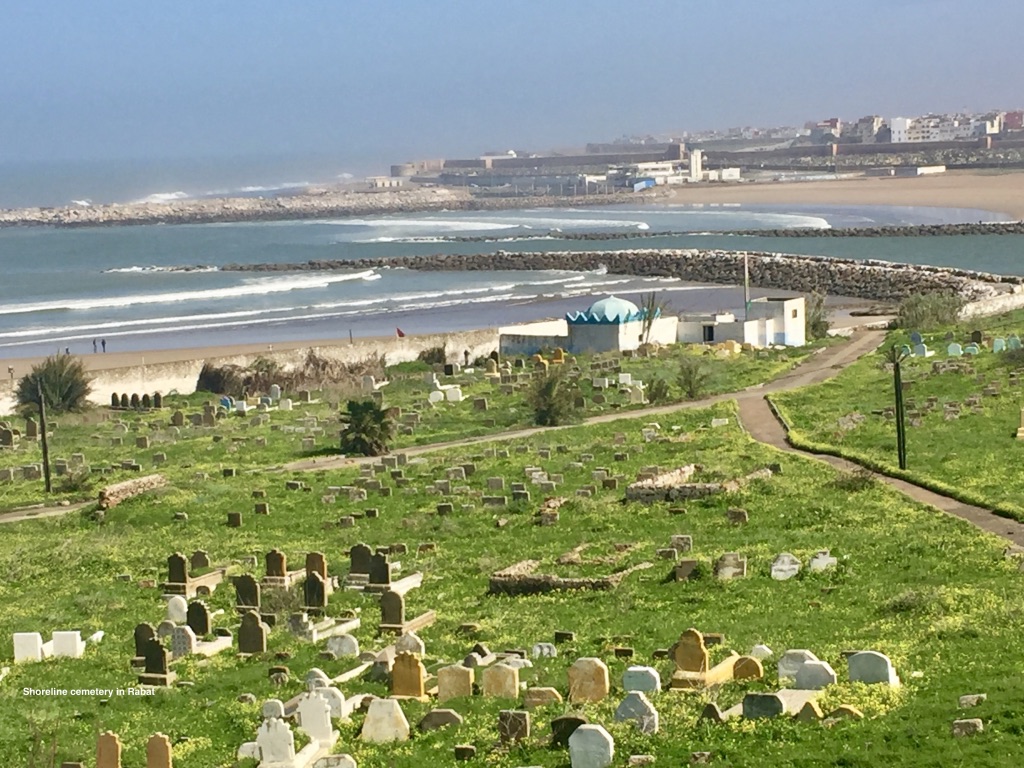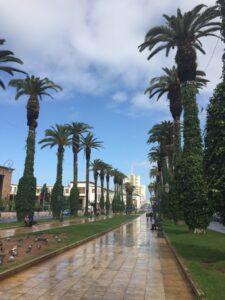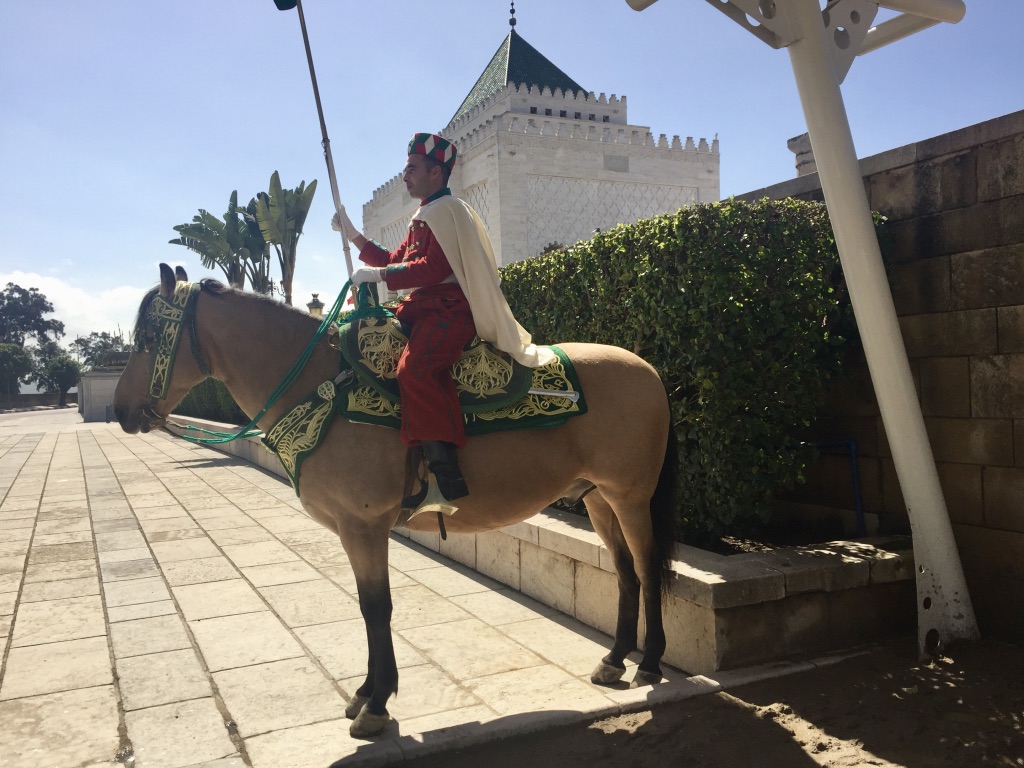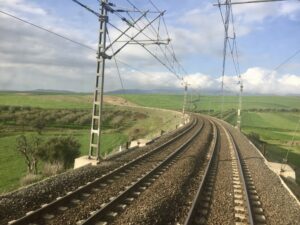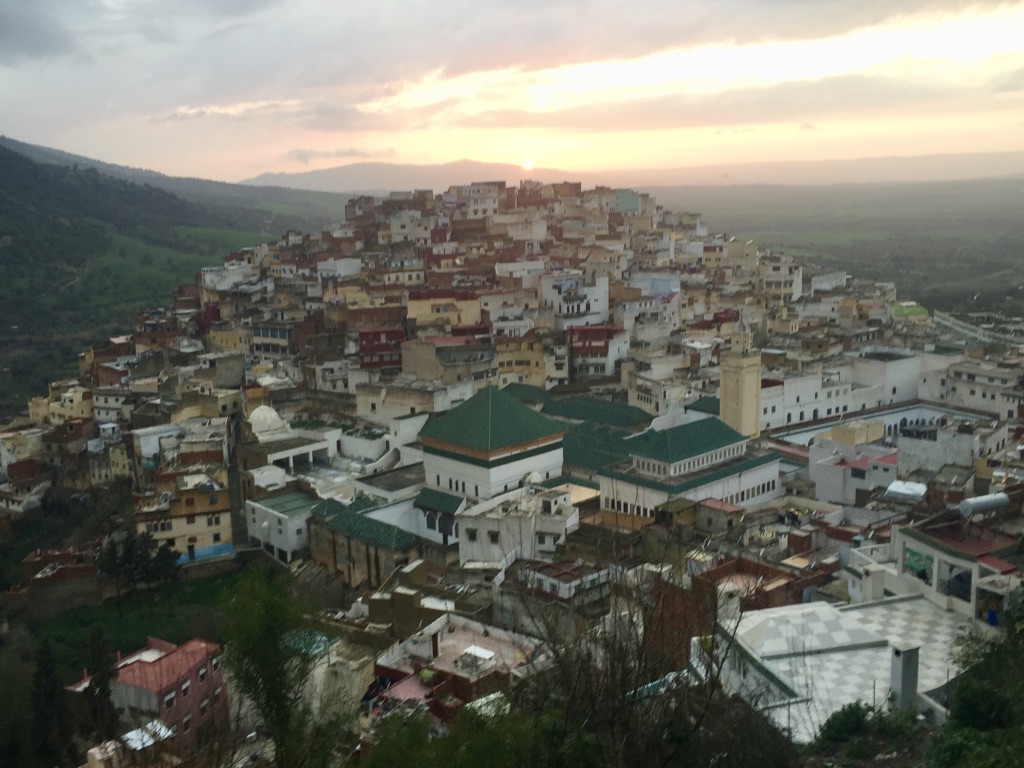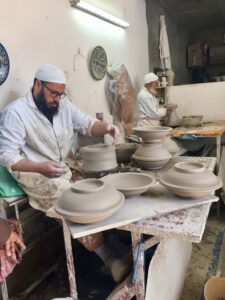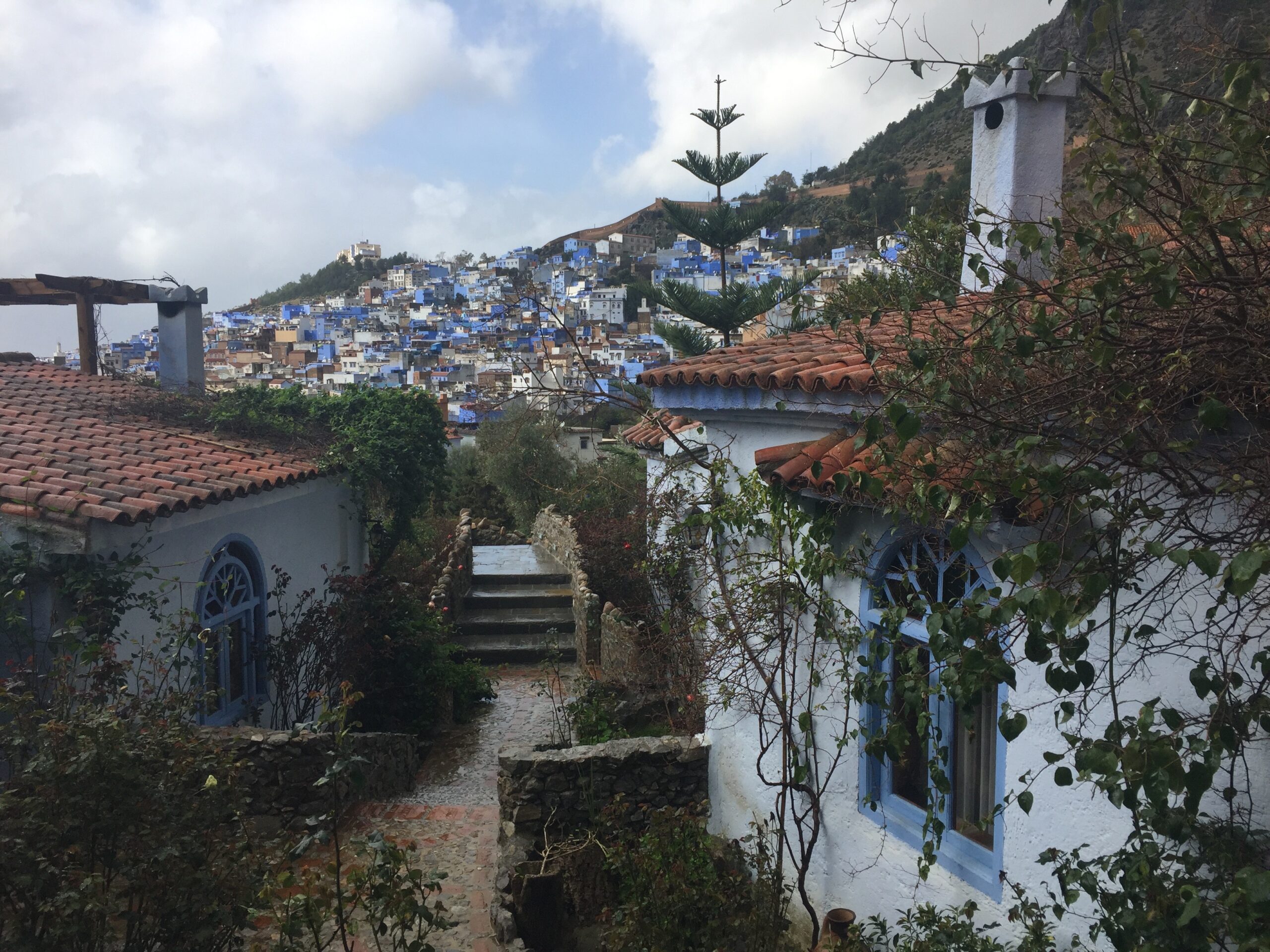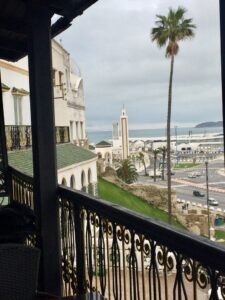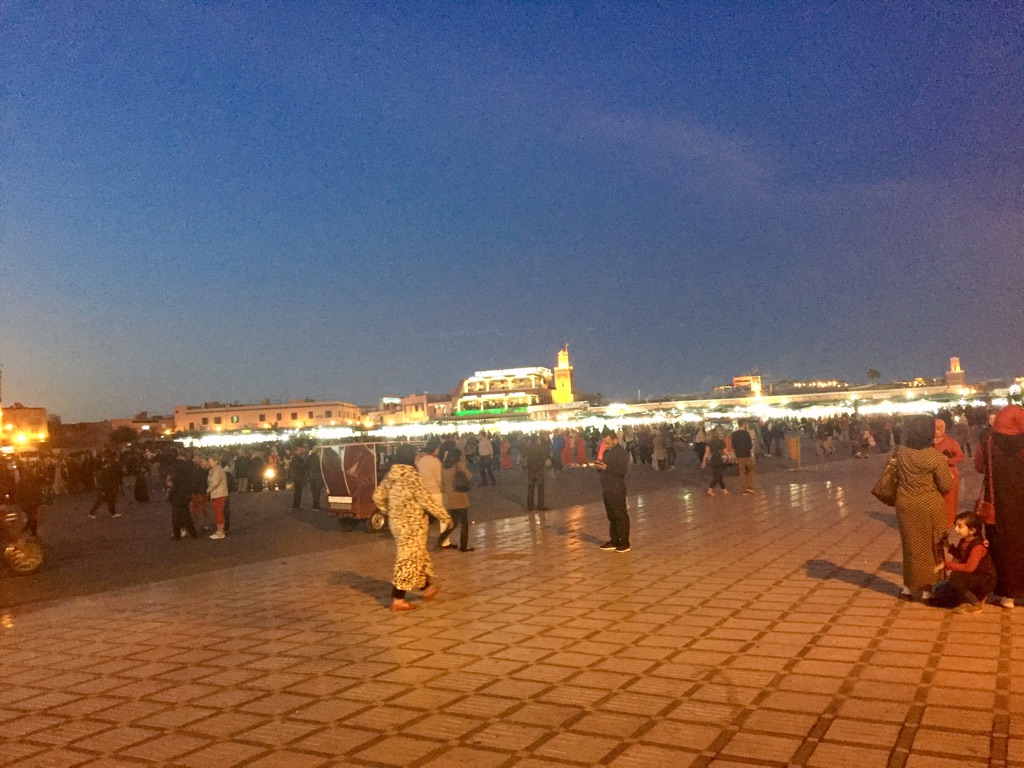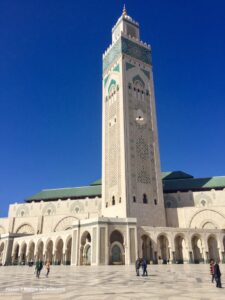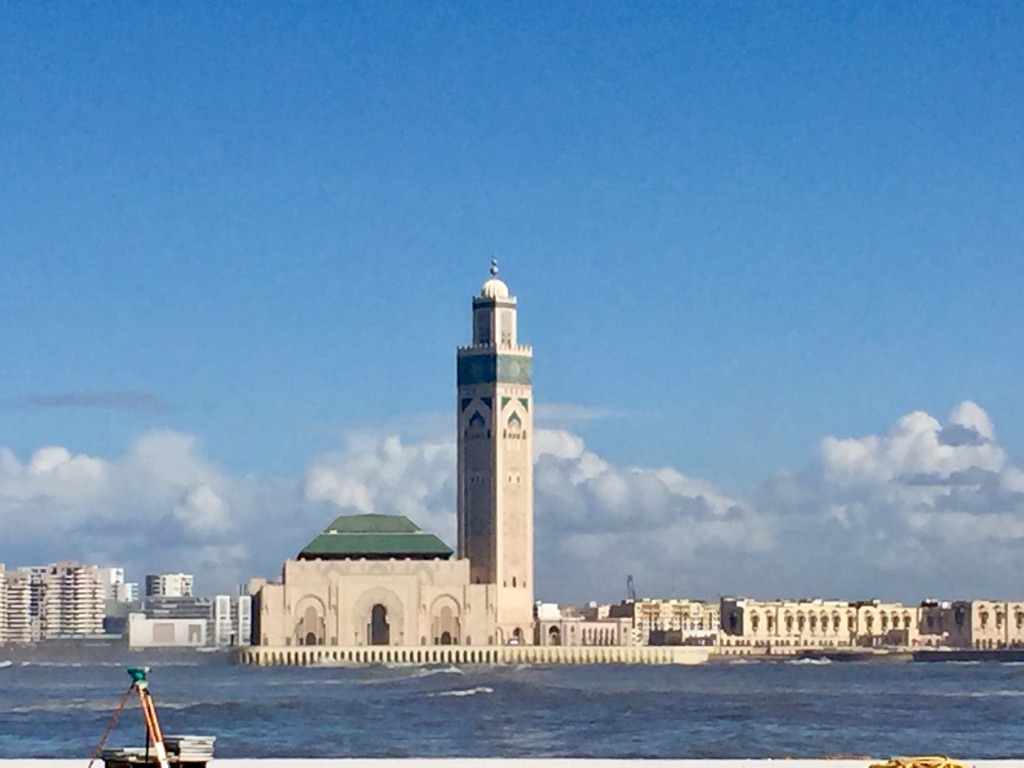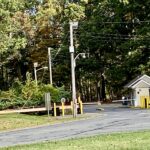I was nervous when I first arrived in Morocco. My muscles tensed. My head got light. I planted my feet firmly on the ground, breathed slowly in, out. I reminded myself that I came to Morocco from Chicago to experience a culture different from my own and that of my ancestors. It is a country whose people practice different religions, speak different languages, hold a longer history, and created a kingdom. My intent was to visit its four imperial cities – Rabat, Meknes, Fes, and Marrakech. I did so much more.
I pulled out a crinkled paper in my pocket that had Mustapha’s phone number on it. He is a Sunni Muslim of Berber (Amazigh) origin, Northwest Africa’s indigenous people. He grew up in the western Sahara Desert near Marrakech, a descendant of nomads, and is now owner of Roaming Camels Morocco. He met me at a designated meeting spot near the train station in Casablanca. His black framed glasses complemented dark fuzzy hair that dropped to his shoulders. A neatly trimmed mustache and short beard surrounded his smile that when widened revealed silver braces on his teeth. A string of leather around his neck dangled a silver pendant, called a Tifinagh or yaz. Of its symbol Mustapha said, “For the Berbers it symbolizes freedom, peace and dignity for all people.” He gave me a quick rundown on what to expect while in Morocco. “It is a progressive Muslim country. You don’t have to cover your head or bow for prayer. The Moroccan people are very friendly so don’t be surprised if you are invited to their house or they put their arms around you. This is normal.” He cautioned me about fake tour guides on the streets and how to take normal precautions while traveling.
I was hungry so we went to a nearby restaurant. A starter dish for any table in Morocco usually includes bread, olives, and cheese. The tagine (Moroccan stew) was served hot in a ceramic dish with chicken, potatoes, olives and sliced vegetables. The waiter exaggerated the pouring of mint tea, outstretched his arm toward the ceiling while the tea cascaded down like a waterfall into the glass. A tourist favorite, I was sure. But ah, the scent of mint leaves. The food was fresh, as if it had just been snapped from the ground. Organic is the rule in Morocco, not the exception.
Arabic and Berber are the country’s official languages but in Casablanca, French is likely. In Tangier, it’s Spanish.
Rabat
After an hour-long train ride to Rabat, Morocco’s capital city, I saw a French influence in the streets’ curly cast iron light poles, tree-lined boulevards and French colonial style architecture.
But all that changed as I moved further into the old section medina (market) where food stalls and shops lined the narrow streets. I was on my way to the Udayas Kasbah, which is a walled city within the city, when I saw the sky spreading itself gallantly over the Atlantic Ocean. An upsweep shoreline was populated with tombstones that looked like an assembled crowd watching the waves slip onto shore. The Kasbah was originally built to fend against invaders and pirate ships. Later it became home to sultans as well as Muslim immigrants fleeing Catholic Spain.
I followed the Kasbah’s winding paths and got lost in its maze. My anxiety grew. It was hot in early March. I feared I might faint. Thoughts of a foreign hospital clouded my thinking. My breath quickened. I tried one path and then another and backtracked trying to find the spot where I started. Watching me was a woman with her head veiled and a cat at her feet. She pointed to where I needed to go. “Sukran,” Thank you, I said. I would learn that the Moroccan people have low tolerance for anyone in distress. They will help. Mustapha was right about that.
Freed from the Kasbah’s web, I headed over to the King Mohammed V mausoleum. Royal guards dressed in red uniforms stood frozen on horseback. Others stood erect under the scalloped arches of the white stone entrance. Out of respect I covered my head with a scarf. I stood on a marble floor beneath the wooden gold leaf ceiling in a viewing gallery above the revered king’s tomb. He was a freedom fighter who helped his country gain independence from France.
Meknes
On the train to Meknes the countryside reminded me of Tuscany with its rolling green hills filled with fields of herbs, orange groves, and olive trees. I arrived on a Friday, the Muslim day of devotion. On this day families solemnly celebrate Allah’s mercy and blessings. It’s reminiscent of the way Sundays used to be observed in the U.S. Many of the shops were closed. The squares were nearly empty. Of the quiet Mustapha said: “Inside the mosques people are asking for and giving forgiveness.”
In preparation for this day of prayer, on Thursdays many Muslims go to a local Hammam (bathhouse) where they engage in traditional bathing and cleansing rituals. Mustapha told me a story of his own childhood. “As a young boy I attended with my mother but when I got older, I no longer wanted to go to the Hammam with her. I was embarrassed because girls my age were there,” he blushed at the memory.
Moulay Idriss
At the nearby sacred pilgrimage village of Moulay Idriss, non-Muslims were not allowed in the mosque. I climbed up what seemed like a thousand steps past the communal bakery to watch the sun set and listen to the Islamic call to prayer echo across miles of valley hills. I let the scene sink inside of me.
By the time I reached the bottom of the stairs the village was dark, lit only by candles. The glow added to the romance of this idyllic place. Then I realized that the village was dark because the electricity had gone out. I rejoined Mustapha for dinner with a family he knew. He was dressed in traditional clothing, a white cloth turban atop his head and a shoulder-to-toe blue kaftan. While preparing food in the kitchen with the family, he told me: “The women make couscous and the men make tagine.” The kitchen was lit by candles and food prepared without electricity. The family offered for us to spend the night. I slept comfortably in a small room off the dining area. Floor to ceiling tiles covered the walls.
Fes
I was amazed at how easy it was to travel by train in Morocco. The next city I visited was Fes, described by Mustapha as the spiritual and cultural heart of Morocco. I was hesitant to enter the medina, the largest of its kind in the world. I was afraid I’d get lost again. Then I watched an old woman walking towards me. Her step slowed as she approached a big drop from the sidewalk onto the street. She lifted her arm as if knowing someone would help her navigate the drop. Which did happen. A young woman came up from behind her, took the old women’s arm, helped her with the step down, crossed the street with her, and helped her step back up onto the sidewalk. The young woman then released her arm and was on her way. I remembered the woman with the cat who steered me in the right direction in Rabat. This willingness to help others happened again and again. Days ago, when it started to rain a man signaled to me where I could find shelter. When a bench was full, a man stood and offered his seat. When I was not sure what train ticket to buy, I was led to an English speaker at the station. These small acts gave me the confidence to enter the medina at Fes.
Inside craftsmen worked at throwing pottery, designing mosaic tiles, and tanning leather. The stench from the leather tannery dye pits was only dissipated when I was given a twig of mint to hold to my nose. The craftsmen paid no attention to me or any other wanderer, keeping their heads down intense on finishing their work.
They left sales to men who were just as intent on getting people to buy. “Lo,” I said meaning “no” in Arabic, but they followed me. Speaking in English they repeated: “It is very good quality. You will miss this.” The prices are not fixed so a buyer has to barter, which I was not good at doing. Most of the business people were men. Most of the people sitting in cafes were men. With no space for cars in the medina, goods are transported in by men with donkeys. It seemed a male-centric society. However, women are represented in Morocco’s parliament. Sixty of the 360 elected members are women.
I found that my sense of direction had greatly improved. In the medina, I watched for landmarks and steadily made my way through the bustling markets stopping to watch the butchers cut up meat. I ate a camel burger which tasted like dry beef. I admired the baskets full of nuts, figs, goat cheese and olives. Two knockers on some of the residential doors aroused my curiosity. A shop owner dressed in black and adorned with silver chains around his neck and wrists told me, “The knockers carry different sounds. One is used by family members and friends so the woman inside will open it. The other is used by strangers and she will not open the door.”
That night, I washed the smell from the tannery dye pits out of my hair.
Chefchaouen
Before heading to Marrakech, I took a side trip by bus through the Rif mountains to a beautiful village called Chefchaouen. The houses, all painted white and blue, looked as if the sky had fallen and left its color there. I hiked a path up the mountains to a small mosque where an Imam was teaching class to elementary school children. The village below looked like a fairyland.
Tangier
Another side trip was by train to Tangier. It is a beautiful, romantic city on the Mediterranean Sea just an hour ferry ride from Spain. Approaching the city, I saw sleek modern high-speed trains parked on tracks. The trains travel from Tangier to Casablanca cutting the former travel time in half. The sky was overcast but it didn’t diminish the city’s allure. The Tangier American Legation Museum is the oldest U. S. diplomatic property in the world, but it was closed the day I arrived. I walked the waterfront promenade and sipped tea on the balcony of the Hotel Continental looking out at the Strait of Gibraltar. I imagined what it was like to travel across the sea in an explorer’s ship. Surely in summer the harbor would be filled with boats from around the world.
The first and only bar I entered while in Morocco was in Tangier. A solo guitar player sang Elvis Presley songs including White Christmas. A picture of Bob Dylan hung on the wall. People were smoking cigarettes. Mustapha said the religious side of government was against alcohol. But in this international city I guessed the rules were relaxed for infidels.
Around the corner from the bar was the train station where I caught the midnight train to Marrakech. I slept soundly in the bed that rocked in rhythm with the train’s rolling wheels. Around 10:00am the next morning I watched the stately snowcapped Atlas Mountains come into view. Tiny white dots near the base were sheep.
Marrakech
At Marrakech’s main square, Djemaa el Fna, a barrage of sights, sounds and smells encompassed me. Rhythmic drumming, clinking cymbals, wafting flutes and guitar-like string instruments called gimri created an orchestra of sounds that pulsed through the square. Plant and herb peddlers stood ready to perform smoke rituals to protect, bless, or alleviate one’s problems. Huddles of people surrounded storytellers who were sharing tales of mystery, adventure, and love. Wheeled carts filled with fresh vegetables and fruits tempted visitors. Henna-painters and street performers all vied for attention. It was a fabulous high energy place. In the nearby medina visitors can find all sorts of hand-made ceramics, clothing, furniture, baskets, you name it. The souks are filled with surprises.
In Marrakech I visited a Hammam to relax and feel pampered. I stood naked while two young women holding buckets splashed water across my body and over my head. In another room, they scrubbed nearly every inch of me and rubbed oils onto my skin. Refreshed, I strolled through the Yves Saint Laurent garden with its bold yellow and cobalt blue planters brimming with exotic plants. The fashion designer’s legacy museum was a block down the street. It is a beautiful, inspirational space. He said that it was while visiting Morocco that he discovered color.
It made me think of all I had discovered while in Morocco. The kindness of strangers, delicious food, various cooking techniques, differences in gender roles, unfamiliar religious traditions, overnight train compartments that fit six. Also, I needn’t be afraid of different. I was in a pensive mood when I returned to the main square. I sat on a balcony and watched the shadows on buildings change as the sun set. The people below started moving in a wave toward a mango-colored sky as the call to prayer began. I hoped their prayers would be answered.
The next day I would say goodbye to Mustapha and get on a train to Casablanca. He had become a friend. I hugged him as I would a brother. His unwavering attention and care continued as he had arranged for a driver to meet me in Casablanca. He insisted I see the Hassan II Mosque in Casablanca before leaving Morocco. “The mosque is cradled by the sea with the world’s highest minaret piercing the sky,” he said.
Casablanca
Back at the train station in Casablanca smiling young men approached me with their nearby car engines running. I looked away to avert their eyes. I was relieved to see Amine, holding a sign with my name on it. Amine grew up in Casablanca. Dangling from his neck was the silver yaz, similar to the one Mustapha wore. I got into the front seat of Amine’s van and began enthusiastically telling him about my trip. I asked if he had been to Tangier, Meknes or Chefchaouen. No answer. He eyed the traffic ahead.
Amine tried hard to understand what I was saying. I began speaking in French. I told him that the must-see mosque Mustapha had mentioned would be my final stop in Morocco. We drove through Casablanca’s business district. It was early spring, but I saw no flowers. When I first spotted the mosque I exclaimed, “Magnifique”. I then stumbled with my French. He wanted to tell me something. He pulled the van over to the curb on a busy street and yelled, “Get out” in English.
“What?” I questioned.
“Get out,” he repeated. I had tossed my luggage in the van’s backseat and wondered if I should leave it or take it with me. I left it. At this sacred place, it would be unusual for him to betray my trust or act with malevolence. A woman’s luggage was not worth bad karma.
Amine signaled with his hands to meet him on the other side of the plaza. I jumped out of the van. Walking towards the towering structure I felt like Dorothy when she first sees the Emerald City in the Land of Oz. But the Hassam II mosque had the Atlantic Ocean as a backdrop. For the past weeks while traveling in Morocco I had not entered any of the mosques either out of respect or it was forbidden. I hadn’t thought to buy a ticket or book a tour which I learned was available to anyone at the Hassam II mosque. I just gazed, circling its sides. I let my eyes trace the brows of arches, climb the lattice shaped tiles and with bended neck looked up, up to the emerald-green tiles. The minaret with three shiny copper circles ascended towards the heavens. It did indeed pierce the sky.
On the other side of the plaza red Moroccan flags flapped in the wind along with Amine’s waving arms. We drove along Casablanca’s shoreline into a desolate lot a few blocks away from the mosque. I wasn’t sure what he was up to. He turned the engine off and got out of the van. He was facing a six-foot-high tin construction fence. No one was around. He gestured for me to follow him. He opened a crack in the fence wide enough for us to fit through. Just beyond the fence was orange dirt and surveyor equipment. When I looked up, I saw the mosque with white cap ocean waves rushing towards its walls. “It is my favorite view,” Amine said.
I understood why it was his favorite and why he wanted to share it with me. I knew this view wouldn’t last. I froze it in my mind. The construction of high-rise buildings was being planned for the shoreline. Occupants of the newly built buildings might take this view for granted. Their eyes won’t trace the waves as ours did. Their bodies won’t feel the pull of the wind, the smell of the sea and the sky cradling us there. Perhaps Mustapha and Amine knew of psychologist Daniel Kahneman’s Peak-End Theory. It describes how we most remember experiences by their intensity and how they ended. I feel my trip to Morocco has never ended as I carry it with me still.

